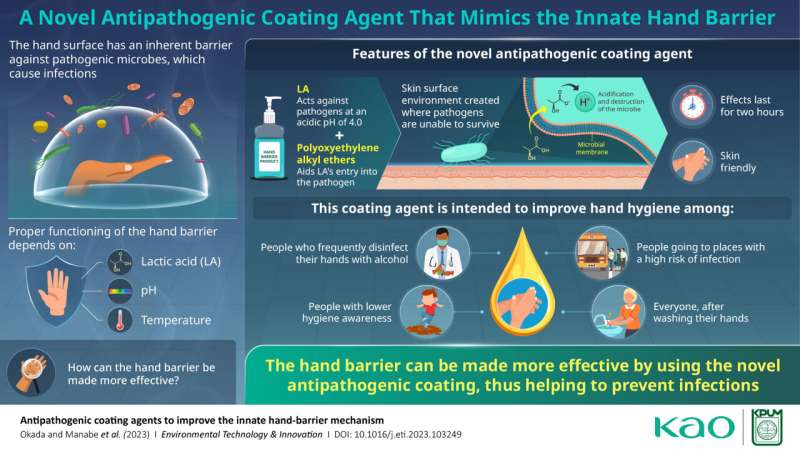This article has been reviewed according to Science X's editorial process and policies. Editors have highlighted the following attributes while ensuring the content's credibility:
fact-checked
peer-reviewed publication
proofread
Novel formulation boosts antimicrobial properties of the natural hand barrier

Contact infection is among the most common ways pathogens, such as bacteria and viruses, spread from one person to another. Hand washing and disinfection are important hygiene practices to minimize the probability of catching infectious diseases. Interestingly, our hands also have a natural barrier that fights off pathogens. While this had been known to science for quite some time, the exact mechanisms by which this barrier acts on pathogens remained a mystery until recently.
In a 2021 study published in Scientific Reports, researchers from Kao Corporation, Japan, revealed that lactic acid (LA), which has a molecular formula of CH3CHCOOH, is the main active component of the natural hand barrier.
Soon after, in another 2021 study published in Skin Research and Technology, they successfully elucidated the mechanisms by which the hand barrier helps kill pathogens. They found that sweat makes lactate (molecular formula of CH3CHCOO-) accumulate on the skin of the hands and that the low surface pH converts lactate into lactic acid (LA).
The relatively high temperature of the hands disrupts the membranes of microbes and makes them permeable to LA. Once inside the pathogens, LA transforms back into lactate and releases the proton (molecular formula of H+). This lowers the internal pH of the microbe and causes DNA damage and metabolic problems.
Using this information, Kao researchers sought a practical way to boost the natural hand barrier to help prevent contact infections. In a joint research effort between Kao Corporation and Kyoto Prefectural University of Medicine, a team of scientists developed a coating agent that can greatly boost the antimicrobial properties of the natural hand barrier.
This study was made available online on June 14, 2023, and is now published in the journal Environmental Technology & Innovation. The project was led by Dr. Kenji Manabe, Manager of the Personal Health Care Products Research Department at Kao Corporation, and also included Assistant Professor Ryohei Hirose from the Kyoto Prefectural University of Medicine.
First, the researchers designed a prototype formulation for the coating agent consisting of LA and a surfactant called polyoxyethylene alkyl ether (POEAE). Through membrane permeability studies in the bacterium Serratia marcescens, they found that the lower the number of oxyethylene groups in the POEAE molecule, the easier it was for LA to pass through the cell membrane, resulting in higher antibacterial activity.
Next, the research team conducted clinical trials on four adult subjects using the prototype formulation. They applied the coating agent on the forearm of the subjects in quantities similar to what one would normally apply when using a commercial hand sanitizer. These experiments showed that the coating agent retained high antimicrobial activity even two hours after the application, showing its potential in everyday life.
Finally, using a model skin evaluation system developed at the Kyoto Prefectural University of Medicine, the researchers quantitatively analyzed the survival time of various bacteria and viruses on human skin tissue samples to which the coating agent was applied. The results showed that the proposed formulation reduced the survival time of coronaviruses and influenza viruses from several hours to under half an hour. Additionally, the survival time of Serratia marcescens dropped from 284 hours to only 9 hours.
Overall, the findings of this study will pave the way for new hygiene products and practices that boost the natural hand barrier to prevent contact infection. These would have important implications in clinical practice and could change how people sanitize their hands.
"Conventional hand hygiene behaviors, such as hand washing and disinfection, are insufficient to address all the contact infection risks. On the other hand, non-alcoholic disinfectants can remain effective on the hands but are known to cause skin irritation when used in high concentrations," explains Dr. Manabe. "In contrast, the proposed skin coating agent is mild on the skin and has a long-lasting effect, making it is easy to use daily. If our newly developed formulation is habitually applied after hand washing, it could complement conventional hand hygiene and reduce the risk of contact infections."
The development of such novel hand hygiene products will help not only keep contact infections at bay but also reduce stress. In this regard, Dr. Manabe concludes, "As we enter the post-pandemic period, hygiene awareness is declining, but many people are still more concerned about infection than ever before. Delivering more effective hand hygiene practices to such people in a way that is less burdensome to their lives can reduce the risk of infection while also delivering psychological relief."
More information: Yasuhiro Okada et al, Antipathogenic coating agents to improve the innate hand-barrier mechanism, Environmental Technology & Innovation (2023). DOI: 10.1016/j.eti.2023.103249
Journal information: Scientific Reports
Provided by Kao Corporation





















